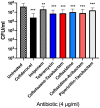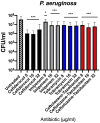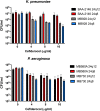Cefiderocol Retains Antibiofilm Activity in Multidrug-Resistant Gram-Negative Pathogens
- PMID: 33199383
- PMCID: PMC7849010
- DOI: 10.1128/AAC.01194-20
Cefiderocol Retains Antibiofilm Activity in Multidrug-Resistant Gram-Negative Pathogens
Abstract
Cefiderocol is a siderophore cephalosporin with potent antibacterial activity against a broad range of Gram-negative pathogens, including multidrug-resistant strains. Siderophore antibiotics bind ferric iron and utilize iron transporters to cross the cell membrane. In the biofilm setting, where antibiotic resistance is high but iron scavenging is important, cefiderocol may have advantageous antimicrobial properties. In this study, we compared the antimicrobial activity of cefiderocol to that of seven commonly used antibiotics in well-characterized multidrug-resistant pathogens and then determined their efficacy in the biofilm setting. MIC90 values for cefiderocol were consistently lower than those of other antibiotics (ceftolozane-tazobactam, ceftazidime-avibactam, ceftazidime, piperacillin-tazobactam, imipenem, and tobramycin) in all strains tested. Cefiderocol treatment displayed a reduction in the levels of Pseudomonas aeruginosa biofilm (93%, P < 0.0001) superior to that seen with the other antibiotics (49% to 82%). Cefiderocol was generally as effective as or superior to the other antibiotics, depending on the pathogen-antibiotic combination, in reducing biofilm in other pathogens. There was a trend toward greater biofilm reduction seen with increased antibiotic dose or with increased frequency of antibiotic treatment. We conclude that cefiderocol effectively reduces biofilm and is a potent inhibitor of planktonic growth across a range of Gram-negative medically important pathogens.
Keywords: Gram negatives; biofilms; cefiderocol; multidrug resistance.
Copyright © 2021 Pybus et al.
Figures






References
-
- (CDC) Centers for Disease Control and Prevention. 2019. Antibiotic resistance threats in the United States. CDC, Atlanta, GA.
Publication types
MeSH terms
Substances
LinkOut - more resources
Full Text Sources
Other Literature Sources

